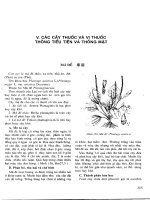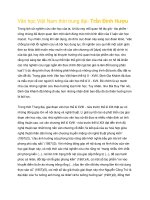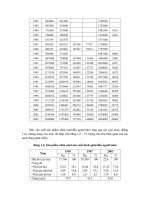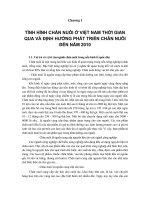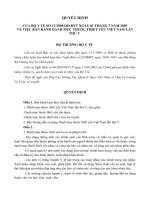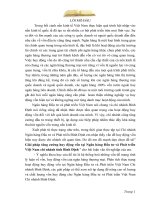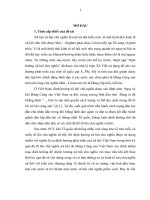Bao viet nam news vit v cao dinh hung
Bạn đang xem bản rút gọn của tài liệu. Xem và tải ngay bản đầy đủ của tài liệu tại đây (133.47 KB, 2 trang )
VIETNAMESE ABROAD
Hybrid eucalypt promises
more than quality timber
By Tran Ngoùc Quang
A
Vietnamese PhD student
studying
in
Australia has made a
major breakthrough in the
propagation of eucalyptus
trees.
The 37-year-old scientist,
Cao ẹỡnh Huứng, has developed a new method of using
synthetic seeds to produce
high-yielding timber forests
and his study was published in
Australia's Botany magazine
last December.
"My research led me to
hybridise the high-yielding,
fast growth rate and excellent
wood quality of the Eucalyptus
citriodora with the disease
resistance and frost tolerant
Eucalyptus torelliana species,"
said Huứng.
"The traditional methods of
propagation from sowing or
taking cuttings failed because
hybrid seeds do not germinate
particularly well and cuttings
are slow to produce roots. My
in vitro clonal propagation
works."
The process involves a small
tree bud being inserted into a
gel bead. After treatment in
the laboratory, the bead grows
new shoots and roots and can
be propagated in a nursery.
Australia's Sunshine Coast
Daily dated December 13, 2010
hailed Huứng's work as a major
breakthrough in botanical science that gave hope to the
carbon battle.
Huứ n g enrolled at the
University of the Sunshine
Coast (USC) a few years ago
due to its reputation as
Australia's leading university
for tropical forestry research.
"I want to complete my PhD
on enhancing hardwood trees
for use in plantations in
Scientist Cao ẹỡnh Huứngs work on creating a fast-growing and
disease resistant type of eucalyptus tree may help improve
afforestation work in Vieọt Nam and other countries in the region.
Cao ẹỡnh Huứng at a University of Sunshine Coast laboratory in Queensland, Australia.
I want to
assist in
reducing
deforestation
by establishing and
improving
plantations.
Australia and Vieọt Nam. I want
to assist in reducing deforestation by establishing and
improving plantations in our
countries," Huứng was quoted by
the daily as saying.
Eucalyptus trees were first
found in Vieọt Nam as early as
1904, and since 1985, plantations
have been expanding rapidly,
either as concentrated industrial plantations or as scattered
forests.
Plantations
The total area of eucalyptus
and acacia plantations in Vieọt
Nam was reported to be 850,000
hectares in 2008. Eucalyptus is
one of the most important
groups of plantation tree
species, mainly used for the
supply of industrial raw materials and fuel in Vieọt Nam.
However, their growth rate is
32
Outlook
February 2011
lower than that of many neighbouring countries and that has
caused problems for the expansion of plantations in the country.
This triggered concerns from
the Ministry of Agriculture and
Rural Development about
being able to achieve its target
of reforesting 5 million ha by
2010 as well as developing a
supply base for a paper industry
producing 1.5 million tonnes a
year and 1.0 million tonnes of
artificial board.
According to the Forest
Science Institute of Vieọt Nam,
hybrid eucalyptus species can
produce wood yields up to 40 50 cubic metres per ha a year.
USC Associate Professor in
Plant
Science
Stephen
Trueman told the paper it was
an easier and much quicker
method of growing a stronger,
selected tree.
"Normally from one seed we
can produce 100 plants in a
year. This way we can produce
about 10 million a year, with
half the process in the lab and
half in the nursery," said
Trueman.
It took almost three years for
his efforts to bear fruit.
Huứng's method of establishing
in vitro and ex vitro clone
banks of juvenile Eucalyptus
torelliana ì E. citriodora trees for
field selection of desired genotypes, was said to have opened
a bright vista for plantation
development in Vieọt Nam and
the tropics of Australia that
would reduce pressures on natural forests and create highquality timber sources.
Australian
tree
species
account for more than half of
the total area of forestry plantations in Vieọt Nam, with eucalyptus being the most dominant
of those species and playing a
very
important
role
in
Vietnamese industry.
"Almost all eucalyptus species
in Vieọt Nam are of low yield
whilst the quality of wood is
lower than those I'm studying
in Australia. I hope that my
research will contribute to
improving the nation's forestry
industry," said Huứng, a graduate
from the Hueỏ University of
Science in the central province
of Thửứa Thieõn Hueỏ, his birthplace.
Huứng has also applied this
technique to highly valued
African mahogany.
ABC News and the Sunshine
Coast Daily reported that Huứng's
new method of producing "New
Type" synthetic seeds to grow
native eucalyptus and African
mahogany, could generate enormous benefits for the construction industry.
"The tree is growing increasingly popular in Australia
because its wood is even more
valuable than eucalyptus and its
bark, seeds and leaves can be
used in the treatment of cancer,
malaria
and
diarrhoea.
However, it is threatened by
overexploitation," Huứng said.
Both eucalyptus and African
mahogany are traditionally
difficult to propagate from
cuttings.
"I have also been working
with
African
mahogany
because this species could be
suitable for high-value timber
can only be found growing on
the streets. The timber is even
more precious than eucalyptus,
and there could be new opportunities for future research
collaborations between Vieọt
Nam and other tropical countries."
Besides hardwood trees,
Huứng also studies medicinal
plants. He said that he had
chosen these areas because
they could contribute the most
to Vieọt Nam.
Indeed, the medicinal value
of wasabi, introduced to Vieọt
Nam over the last decade, has
been developed by Huứng's
research.
Wasabi treatment
Huứng says he chose to study at the USC due to the institutions
reputation as a leading centre for the study of tropical forestry.
Huứng with some of the seedlings he raised using an in vitro
clonal propagation process.
plantations in Vieọt Nam in
the near future," he said.
"The importance of this tree
species has not yet been
realised in Vieọt Nam and at
present, African mahogany
Outlook
February 2011
33
He successfully extracted
allyl isothiocyanate, one of the
most important medicinal
compounds in wasabi, that can
be used for not only the treatment of cancer, asthma and
toothache, but also for the
prevention of blood clotting.
At the same time, he developed a way of increasing the
content of this medicinal compound using induced mutation
methods, and this valuable
research was published in the
international journal In-vitro
Plant in 2008.
He achieved a first class master's degree in 2007 at the
University of Technology in
Sydney and subsequently
received numerous invitations
from prestigious international
universities, but Huứng decided
to enrol at USC.
Huứng said his research had
helped him to realise a childhood dream of becoming a scientist.
According to USC, Huứng has
devoted almost all of his free
time to research in campus
laboratories, and has been
recognised as an outstanding
researcher.
Huứng explained that he had
undertaken globally important research projects and
achieved excellent results for
the sake of the socio-economic development of Vieọt
Nam.

